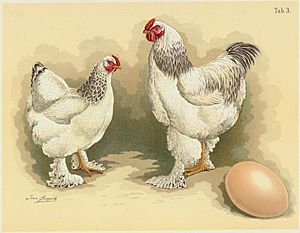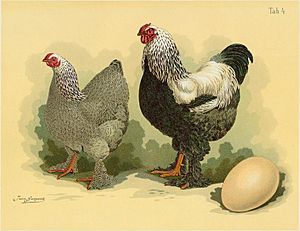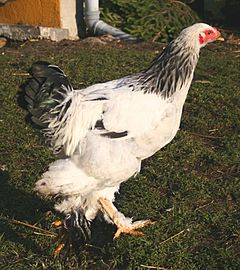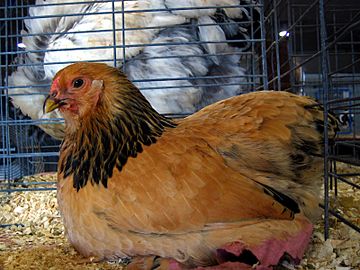Brahma chicken facts for kids
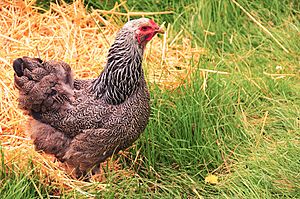
A Dark Brahma hen
|
|
| Other names |
|
|---|---|
| Country of origin | United States |
| Traits | |
| Weight |
|
| Egg color | brown |
| Comb type | pea |
| Classification | |
| APA | Asiatic |
| ABA | feather legged |
| EE | yes |
| PCGB | soft feather: heavy |
|
|
The Brahma is a special type of chicken that came from the United States. It was created using birds brought from a Chinese port called Shanghai. For many years, from the 1850s until about 1930, the Brahma was the most important chicken breed for meat in America.
Contents
History of the Brahma Chicken
The exact beginning of the Brahma chicken was a bit confusing for a while. It seems to have started in the United States. Large birds with lots of feathers on their legs were brought from the Chinese port of Shanghai in the 1840s. These were known as "Shanghai" birds.
The unique head shape and pea comb (a type of comb on a chicken's head) of the Brahma probably came from mixing them with Grey Chittagong birds. These birds were a type of Malay chicken. They were imported from Chittagong in eastern Bengal (which is now Bangladesh). These features help tell the Brahma apart from the Cochin chicken, which also came from "Shanghai" birds.
At first, there were many different kinds of Brahma chickens. They also had at least twelve different names! In 1852, some chicken judges met in Boston. They decided to call the breed "Brahmapootra." Later, this name was shortened to "Brahma."
Brahmas were first sent to England in December 1852. A man named George Burnham sent nine "Gray Shanghaes" as a gift to Queen Victoria. English breeders then developed the Dark Brahma type from these birds. This new type was later sent back to the United States. Both the light and the dark Brahma were included in the first British Poultry Standard in 1865. This was a book that described what different chicken breeds should look like.
Both the light and the dark Brahma were also included in the first Standard of Perfection by the American Poultry Association in 1874. A third color, the buff Brahma, was added to the standards later, around 1924 or 1929.
The Brahma was the main chicken breed used for meat in the US from the 1850s until about 1930. Some of these chickens grew very large. Roosters could weigh about 8 kilograms (17.6 pounds), and hens could weigh around 6 kilograms (13.2 pounds).
What Makes Brahma Chickens Special?
The American Standard of Perfection officially recognizes three main color varieties of Brahma chickens. These are light, dark, and buff.
- The light Brahma is mostly white. It has black feathers around its neck (called hackles) that are edged with white. Its tail is black. Male light Brahmas also have black stripes on their saddle feathers (feathers on their lower back).
- The dark Brahma has the biggest differences between the male and female chickens. The hen has a dark gray and black pattern, like a pencil drawing. Her neck feathers are like the light Brahma. The male dark Brahma has black and white neck and saddle feathers. His body and tail are black. His wings have white shoulders, and his main flight feathers are edged with white.
- The buff Brahma has the same black patterns as the light Brahma. However, instead of white, its main color is a golden buff.
The Australian Poultry Association has also accepted other colors for Brahma chickens. These include black, blue, partridge, crele, and barred types.
On average, male Brahma chickens (roosters) weigh about 5.5 kilograms (12.1 pounds). Female Brahma chickens (hens) weigh around 4.5 kilograms (9.9 pounds).
How Brahma Chickens Are Used
The Brahma chicken was very important for meat in the United States from the 1850s until about 1930. They are also good at laying eggs, even in winter. They lay large, brown eggs. These eggs usually weigh about 55 to 60 grams (about 2 ounces).
See also
 In Spanish: Brahma (gallina) para niños
In Spanish: Brahma (gallina) para niños


